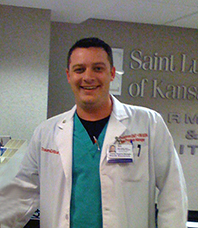

David Seastrom RN, BSN
David Seastrom is the Injury Prevention, Outreach & Education Coordinator for the Trauma & Burn Service at Children’s Mercy Kansas City - which is the only Pediatric Level I Trauma Center between St. Louis and Denver. After graduating from Kansas State University he attended Baker University School of Nursing and went on to be an Emergency Medical Technician Intermediate for seven years and a critical care transport nurse for two. He has been a registered nurse for the past 14 years with experience in pre-hospital, emergency, critical care & flight nursing. In addition, David has experience in trauma center management in both adult and pediatrics and level I and level II trauma centers.
David is very active in pediatric trauma injury prevention. He is a member of several professional organizations, including the Emergency Nurses Association and Pediatric Trauma Society, and has published several articles in reference to pediatric trauma and concussions. David is an active participant on multiple state committees to include the Missouri State Advisory Council Pediatric Sub-Committee, the trauma sub-committee and the professional and public education workgroups. He also serves as a representative to the Kansas and Missouri Emergency Medical Services for Children programs. In the state of Missouri his is the Appointee to the U.S. Department of Health and Human Services – Roundtable on the Movement of Pediatric Patients in Disasters.
David has spoken all over the country to professional healthcare audiences including EMS, Nurse and Physicians. He promotes educational development and training with special interest in stabilization & transport, trauma center development and pediatric trauma resuscitation. With a very enthusiastic approach to education he enjoys being able to make his audiences laugh while they learn about children and their special needs.
Speaking Topics
Pediatric Trauma: The Hurts Bad
• Review the diagnostic approach to the pediatric trauma patient
• Discuss differences between adult and pediatric trauma patients
• Discuss trends in pediatric airway management, transport & overall careThis lecture reinforces and strengthens the healthcare provider’s knowledge in Pediatric Trauma. The lecture will cover a variety of topics to include the differing etiology in pediatric trauma, the anatomical & physiological differences between adults from children and the current treatments and trends in airway management, stabilization & transport and overall management.
Extreme Cases in Pediatric Trauma I
• Discuss uncommon injuries found in the pediatric trauma population
• Identify management priorities for the critically injured pediatric trauma patient
• Review the resuscitation of major dog bite injuriesChildren have a habit of getting into things and places they aren’t supposed to. This lecture will review some of the uncommon injuries found in the pediatric trauma population. Some cases in this presentation are humorous while others are of a very serious nature. Some less common alternative treatments will be reviewed with these cases.
Extreme Cases in Pediatric Trauma II
• Discuss uncommon injuries found in the pediatric trauma population
• Identify management priorities for the critically injured pediatric trauma patient
• Review the resuscitation of major dog bite injuriesBuilding on its preceding lecture, this will wow and amaze participants with visual images, case studies and pediatric stories of life and death. Children have a habit of getting into things and places they aren’t supposed to. This lecture reviews some of the common and uncommon injuries found in the pediatric trauma population. Case studies in this lecture stimulate participants to use critical thinking to anticipate the plan of care and largely focus on the appropriate resuscitation of a pediatric trauma patient (lethal triad).
Pediatric Burns: “The Hot Stuff”
• Describe the characteristics of partial and full thickness burns
• Describe the appropriate use of the Parkland Burn Formula
• Identify primary injuries related to electrical and gasoline burnsIn the United States there are approximately 2 million burn patients that are seen in Burn Centers, of those 2 million, 450,000 are children. This lecture will differentiate the etiologies of burns varying from thermal, to electrical to chemical with the treatments and management priorities explained. The participant will be able to understand burn resuscitation and be able to use the Parkland Formula correctly. This lecture is great for any individual not working in a specialized Burn Center and will enhance their knowledge if they are.
Stupid Kid Tricks
• Describe the effects of drug use/overdose in the pediatric population
• Understand the importance of a thorough evaluation of the pediatric trauma patient to minimize the life-threatening occult injuries
• Describe unconventional treatments for children with uncommon injuriesThis lecture focuses on 3 of the common mechanisms of injury for the pediatric trauma population: Pills, Spills & Thrills. The pills section covers the basics of pediatric overdoses with helpful insights of what to look for and works in some comic relief by some great and amusing pictures. The spills topic covers some of the most common injuries in children sustained by falls and their treatments and the reminder to never underestimate the occult injury. Lastly is the thrills section where we see pediatric trauma at its worst from lawnmower incidents, life threatening dog bites and major burn patients. This lecture is assured to wow your participants.
Concussions: A Wolf in Sheep’s Clothing
• Review current assessment guidelines for patients who have sustained a concussion
• Identify management priorities for the pediatric patient who has sustained a concussion
• Identify long-term effects from concussionsThis lecture focuses on the emerging research and literature concerning concussions. The lecture focuses on the pathophysiology surrounding concussions and the body’s healing process. Major topics of secondary impact syndrome and repetitive concussive syndrome are also discussed. Realization of the risk factors for sustaining a concussion such as age, sex, previous medical history will be discussed. This lecture is perfect for any healthcare provider providing care to children at risk for sustaining a concussion.
-
Watch a Short Video of David's Teaching Style